If you’re a fan of beautiful and unique glassware, you will want to check out Federal glassware for your home. Often referred to as Depression glass today, these beautiful pieces are known for their bright colors and gorgeous patterns. Whether you are looking for plates and bowls or glasses and sherbet cups, these Depression glass pieces are easy to find and a joy to add to your dining collection.
In this article, we’ll cover more about the types of valuable Federal glass patterns that are available, as well as how to identify the Federal glass from other types of glassware out in the market.
Let’s get started!
Table of Contents
A Brief History of the Federal Glass Company
While there were a few different manufacturers creating class dinnerware around this same time, one of the best known is the Federal Glass Company.
The Federal Glass Company was founded in Columbus, Ohio, in 1900. In its early years, the company produced pressed-glass tableware and tumblers. This means they used molds in which to press their glass to create their pieces.
By the Great Depression of the 1930s, Federal Glass patterns became increasingly popular, creating high quality glassware for low prices.
They made a wide variety of pieces, too. Not just the everyday plates, bowls, and cups. The Federal Glass Company also created interesting dinnerware like toothpick holders, jars, candlesticks, covered butter dishes, jam dishes, and shot glasses. They even made industrial dinnerware for places like restaurants, hotels, and bars, and people gave them away as cereal box prizes and as gifts for visiting the movie theater.
By the 1940s, federal glass was one of the largest producers of drinking glasses in the United States. They continued to produce dinnerware until they finally closed in the late 1970s.
How Do I Identify Federal Glass?
Now that you know a little about the history of the Federal Glass Company, you may want to know how to identify if the dinnerware you own is indeed Federal glass.
“F In a Shield” Trademark
The best way to know is by checking for the Federal Glass Company trademark on the bottom of your dinnerware pieces. Federal glass is usually marked with a “F” inside of a shield. This trademark was acquired around 1932, yet it is believed that catalogues actually displayed Federal glass with this logo as early as 1927.
So if you find an “F” within a shield on the bottom of your dinnerware, you’re sure to have some Federal Glass in your possession.
Bright, Cheery Colors or Designs
If you’re not sure whether a piece of glassware is Federal, check out the colors and designs. If your pieces are interesting colors like yellow, cobalt blue, green, or pink, they very well may be Federal glass. Or even if you have tumblers, for example, that are white or clear but have fun, whimsical designs on them, they may also be Federal glass.
Valuable Federal Glass Patterns
While federal glass is generally affordable, there are some patterns that are more valuable than others. Some are also easily recognizable above other patterns.
Let’s look at a few valuable Federal Glass patterns that collectors love to find on the market:
Diana Pattern
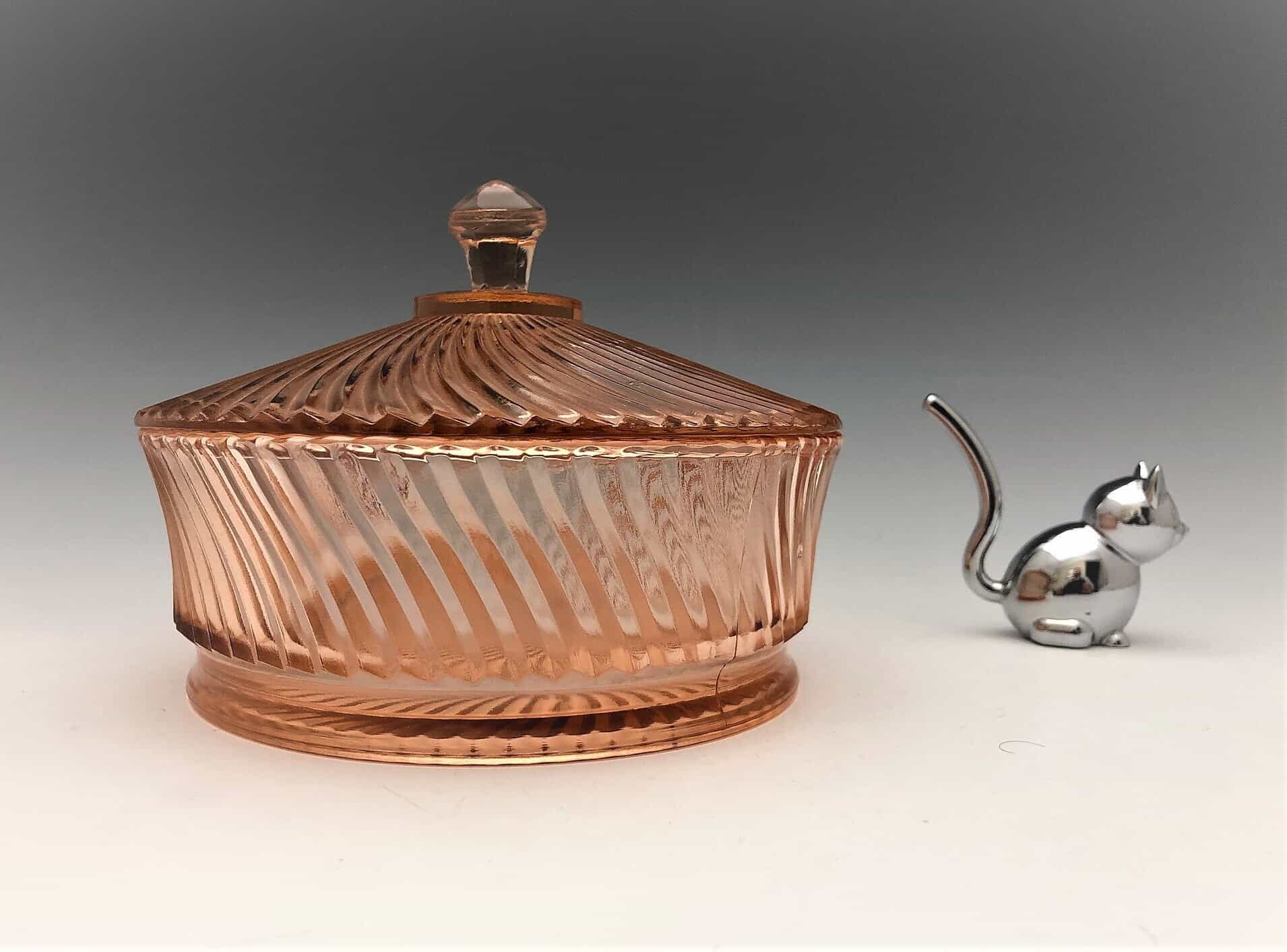
The Diana pattern was produced by Federal Glass from 1937 to 1941. It features a ribbed design in the glass that swirls around the edges in a wave formation.
Diana patterns are most commonly found in pink, amber, green, or crystal and are pretty valuable. For example, a single creamer cup can cost easily over $45.
Madrid Pattern
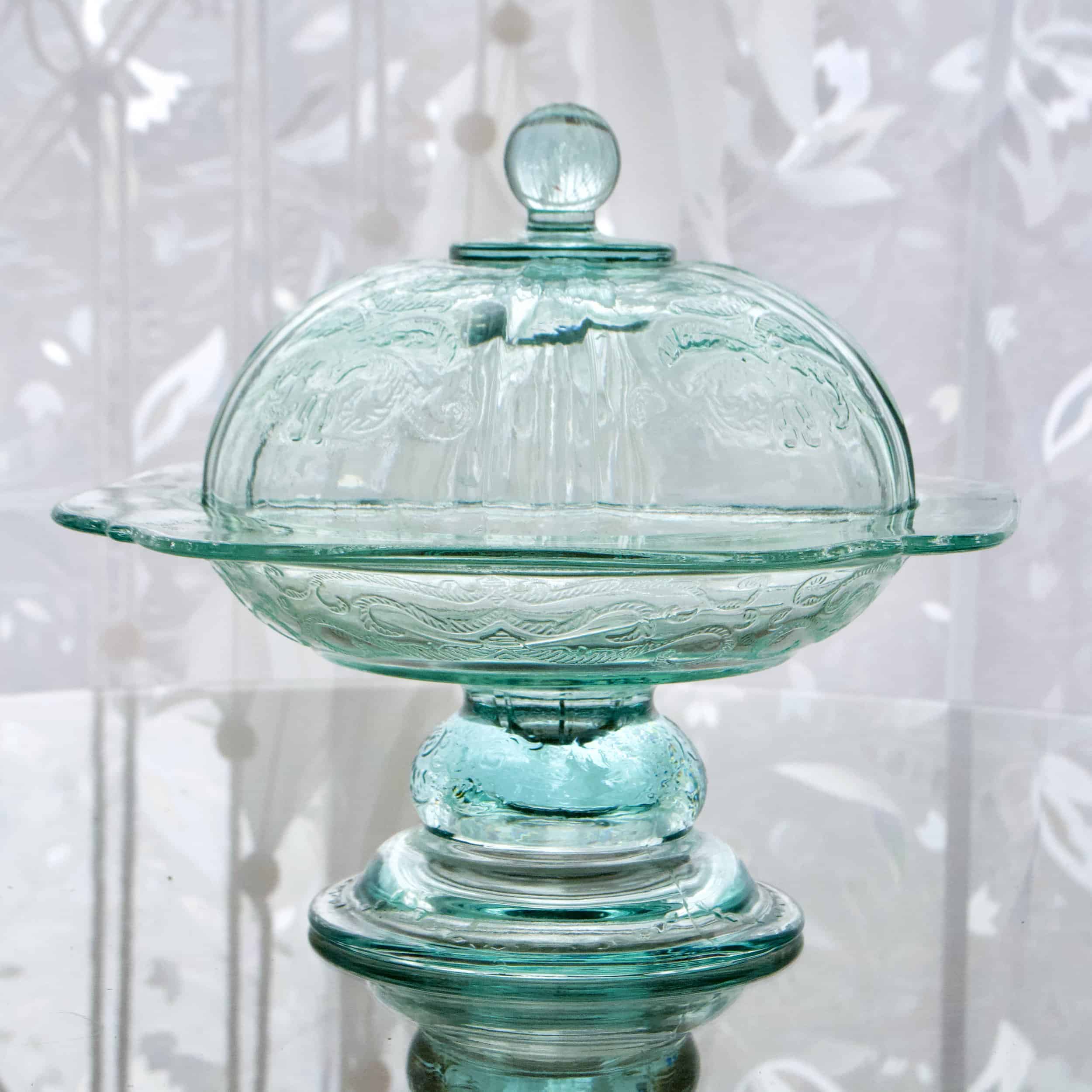
The short-lived Madrid pattern was introduced in 1932 to 1939 and is one of the more classic federal glass patterns. It features a fancy floral and filigree design in a variety of colors, including opaque blue, clear, and yellow. You can find a single plate replacement for anywhere from a few dollars to over $20.
Lovebirds Pattern
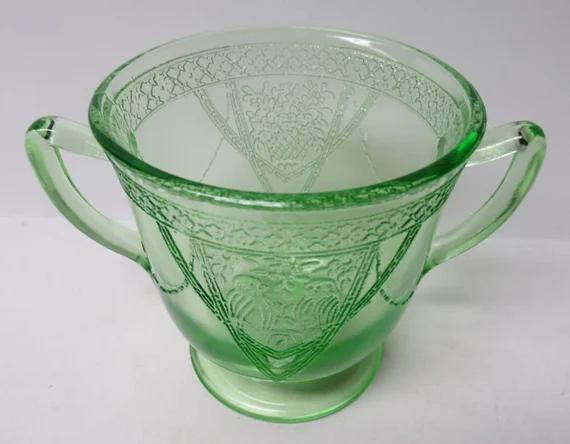
The Lovebirds pattern (also known as the Georgian) was introduced in the late 1940s and features two birds sitting on a branch among geometric shapes and delicate foliage. The Lovebirds pattern is most commonly found in green. For these pieces, you could pay anywhere from about $9 to $45 per dinnerplate.
Heritage Pattern
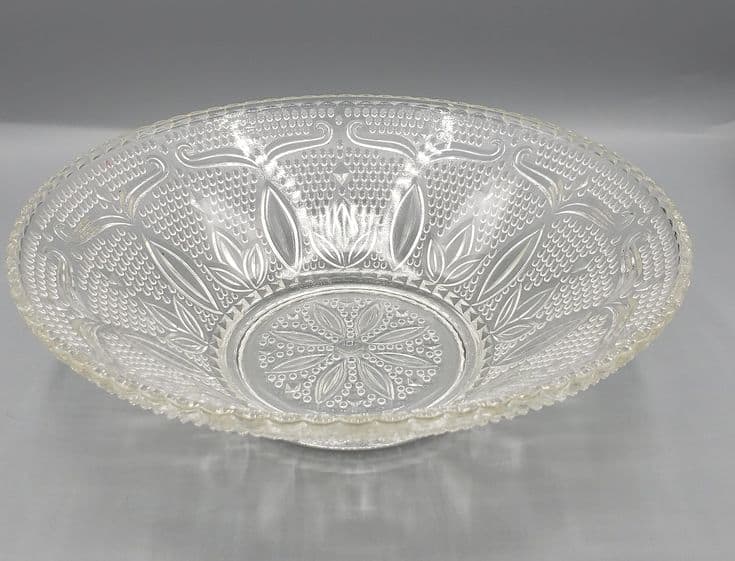
The heritage pattern was introduced in 1940 until 1955 and is one of the more popular Federal Glass patterns. It features a scrolling design of flowers, dots, and ribbon. Heritage patterns are most commonly found in crystal clear. A footed creamer could sell for up tp $35!
Cameo Pattern
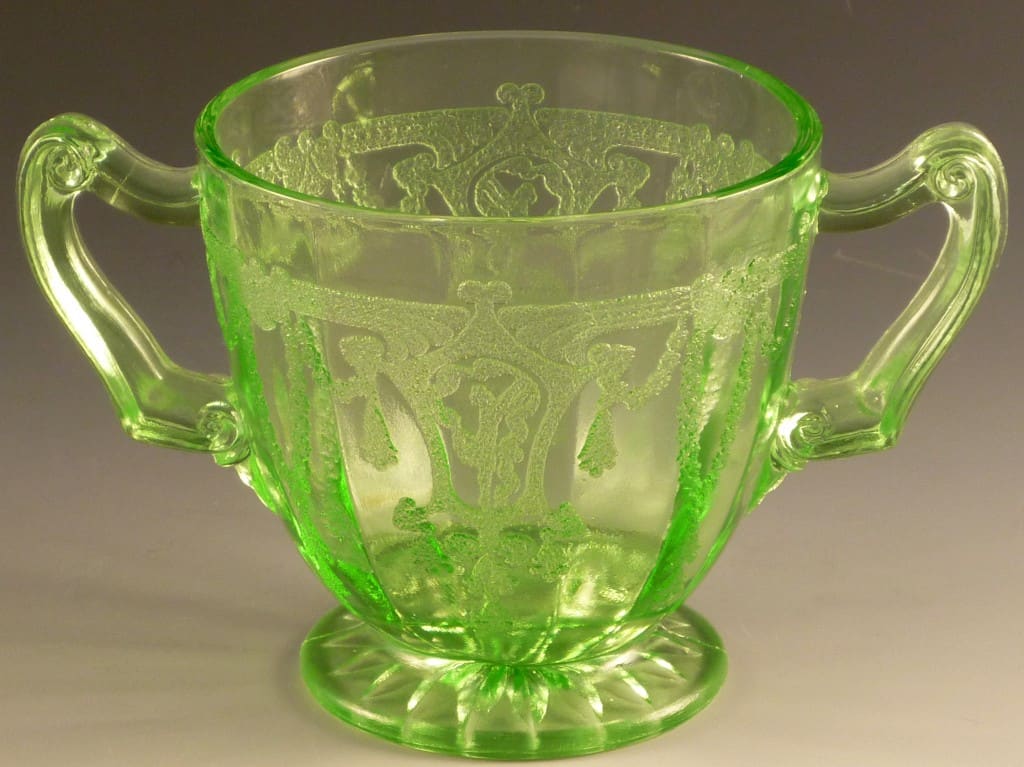
The Cameo pattern was introduced in the 1950s. The glass is clear and has an etched floral wreath design, sometimes with more foliage found within the wreath and sometimes with nothing inside. Cameo patterns are most commonly found on clear glass. A set of 10 juice glasses could go for $55.
Mayfair Pattern
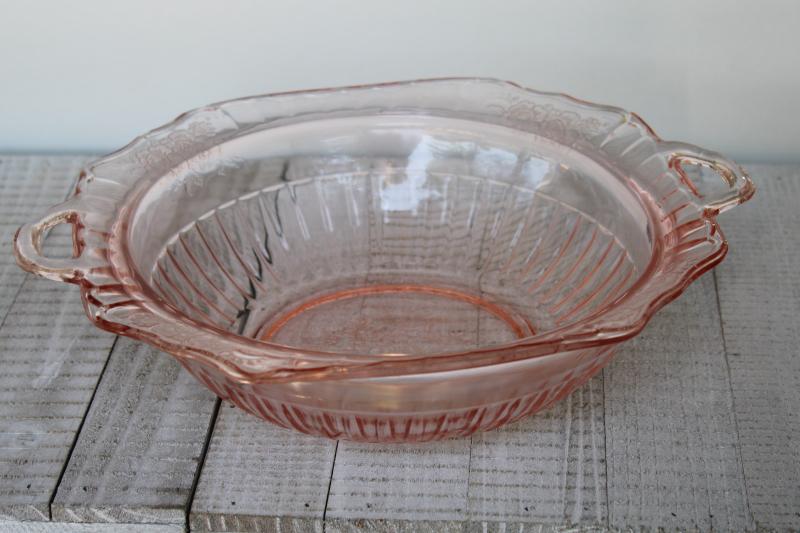
Another beautiful pattern of the Federal Glass Company is the Mayfair pattern. In it, the pattern shows geometric shapes surrounding a small bouquet of flowers, and the edges of the plates and rims of the cups are scalloped. They often come in clear and gold, and a grilling plate can go for $10!
Parrot Pattern
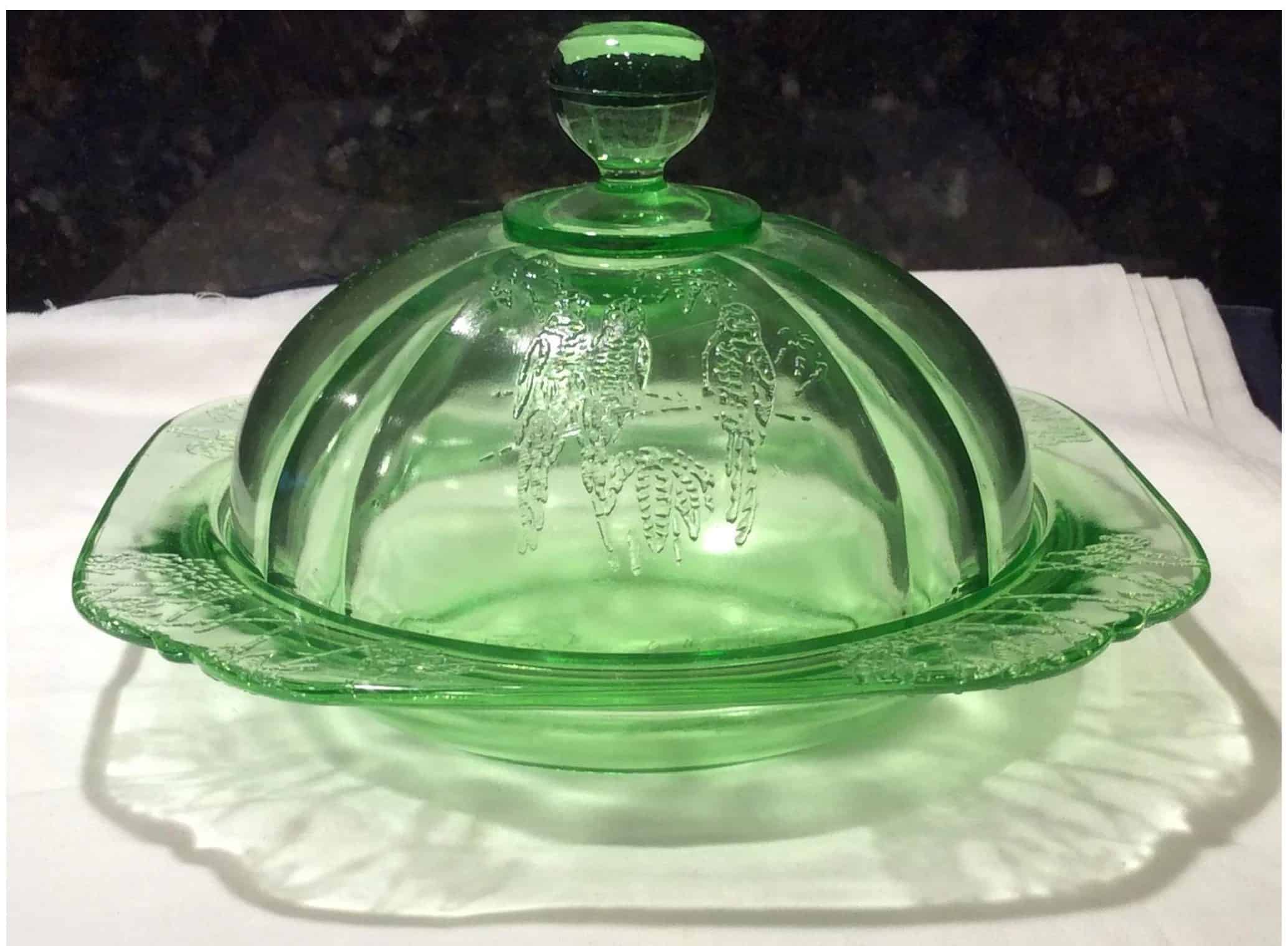
The Parrot pattern was a very short-lived pattern introduced in 1930 and discontinued by 1931. As you might guess from the name, this pattern features a two-parrot design that is found within a wreath of leaves. The Parrot pattern is most commonly found in green or yellow and is quite valuable. It can be worth up to $140 for an open butter dish, $100 for an 8″ fruit bowl, and a whopping $360 for cute little salt and pepper shakers.
Normandie Pattern
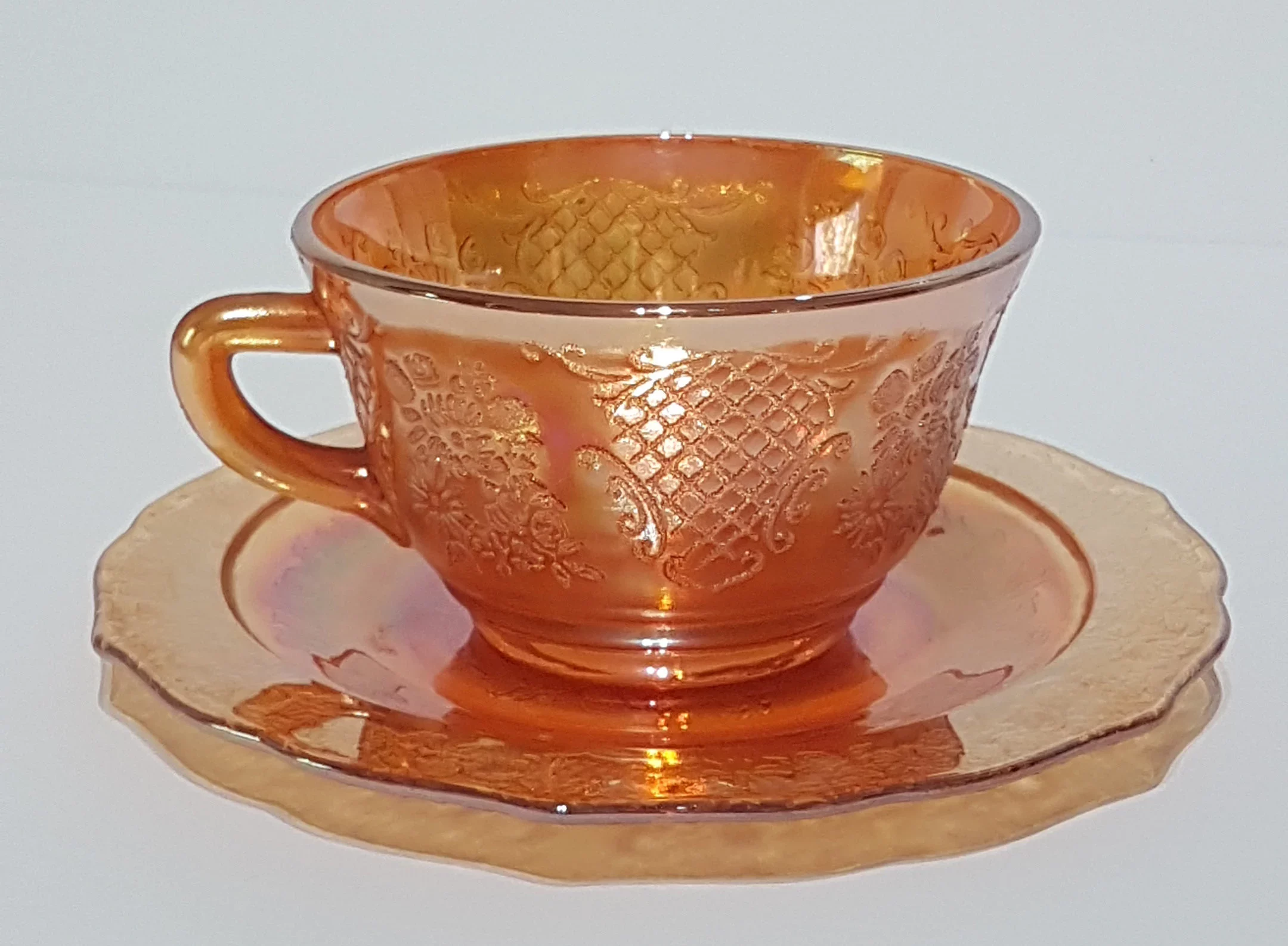
The Normandie pattern is one of the most rich and beautiful patterns of Federal glass. Etched into the walls of each sherbet bowl, cup, and footed open sugar bowl is an alternating pattern of a splash of flowers and a crisscross grape-like pattern. The saucers are smooth glass and the dinner plates have a repeating floral wreath-like pattern around the rim with a grouping of flowers in the center.
This pattern often comes in marigold, a color not often seen in the other patterns. Also, the marigold color sometimes comes in translucent, opaque, and iridescent, which almost gives the Normandie pieces the appearance of copper. You can also find Normandie in amber, pink, and clear.
There is a wide range of values for Normandie patterned pieces. For example, an iridescent marigold cup and saucer can go for $9, while a flat tumbler in pink could go for $59. The most impressive prices include a flat iced tea tumbler in pink for $140, a footed open sugar bowl in pink for $150, and an 11-inch dinner plate in pink for and amazing $250!
Hazel Atlas Pattern
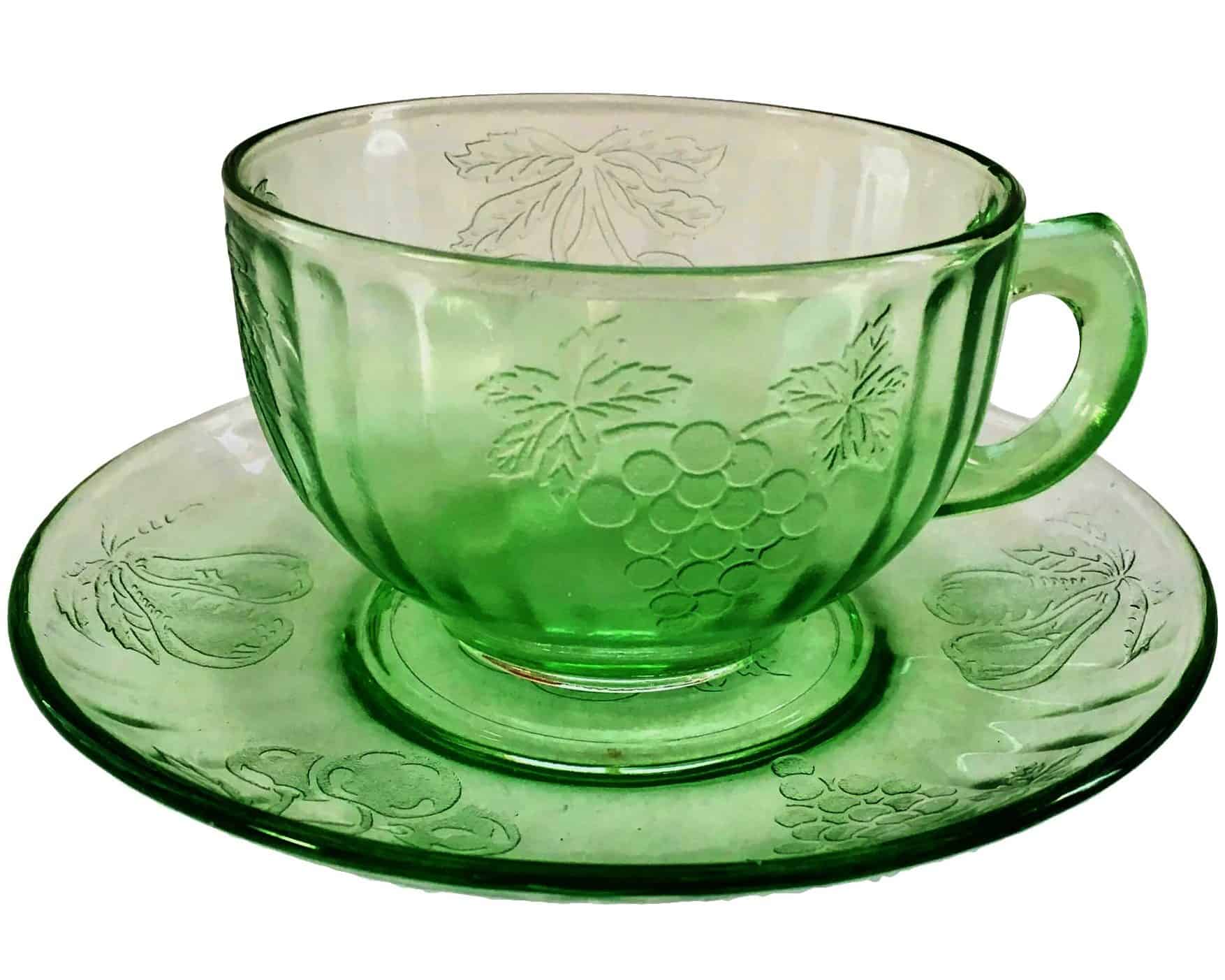
The Hazel Atlas pattern was introduced as a 1930’s design. It is a beautiful yet simple and classic pattern with vertical grooves climbing the walls of bowls and cups. These pieces also feature a very nice wide rim and often come in bright green or pale yellow. Though the Hazel Atlas pattern is sometimes difficult to find, a set of four glass sherbet bowls in this pattern can go for around $40.
Royal Lace Pattern
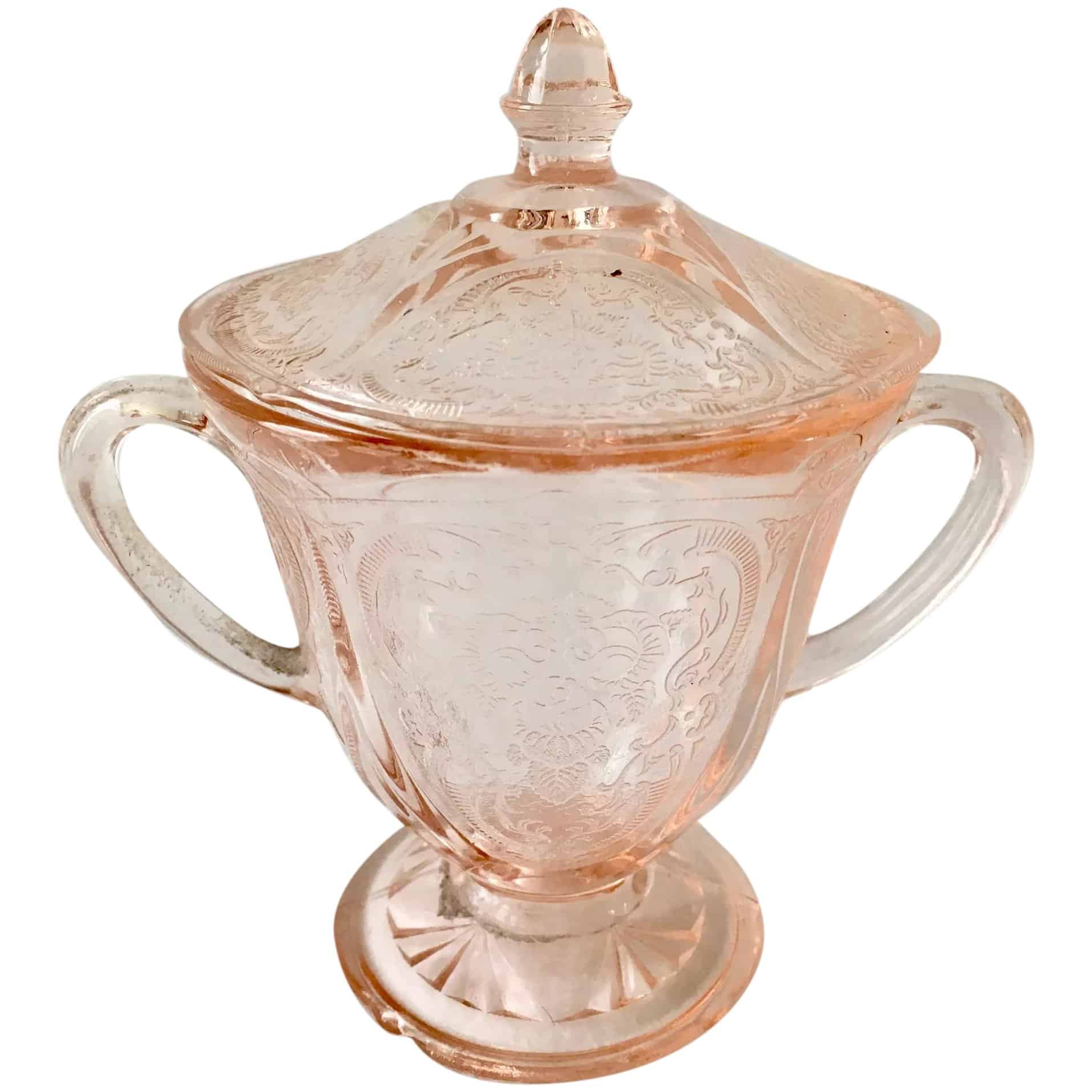
The Royal Lace pattern was introduced in the 1930s (1934 to 1941 to be exact) and is one of the more popular and also one of the most rare Federal Glass patterns, especially in cobalt blue. Striking and beautiful, this pattern features a design of amazing foliage and filigree. Glass dinnerware in this pattern can go for $200 for a large pitcher and an impressive $600 for a round covered butter dish!
What is the Value of Federal Glass?
Now that we have looked at several beautiful patterns from the Federal Glass Company, now let’s examine what the value is of Federal Glass.
The value of Federal Glass depends on the pattern, age, condition, and rarity. Some Federal Glass patterns, like the Diana and Madrid patterns (an any we mentioned above!), are more valuable than others.
Let’s take a closer look at the factors that affect the value of Depression glass patterns:
- Age – As a general rule of thumb, a Federal Glass piece that is older is more likely to be valuable than a newer piece is.
- Condition – If a piece is in perfect condition, without any chips, cracks, or scratches, it will be likely be worth more than a piece that is not in perfect condition.
- Rarity – If a pattern is no longer being manufactured and is hard to find, it will be worth more. Just like these Royal Lace pattern pieces: a cookie jar for up to $550 and a water tumbler for up to $85!
In Conclusion
To sum it up, federal glass patterns are a great option for collectors and those looking for affordable glassware. Be sure to do your research before you buy, as some federal glass patterns are more valuable than others. And if you’re not sure whether a piece of glassware is federal, take a look at the design or check for a stamp that says “F” in a shield.
Do you have any good old classic “Federal Glass” or Depression glass dinnerware? Tell us about it in the comments below!
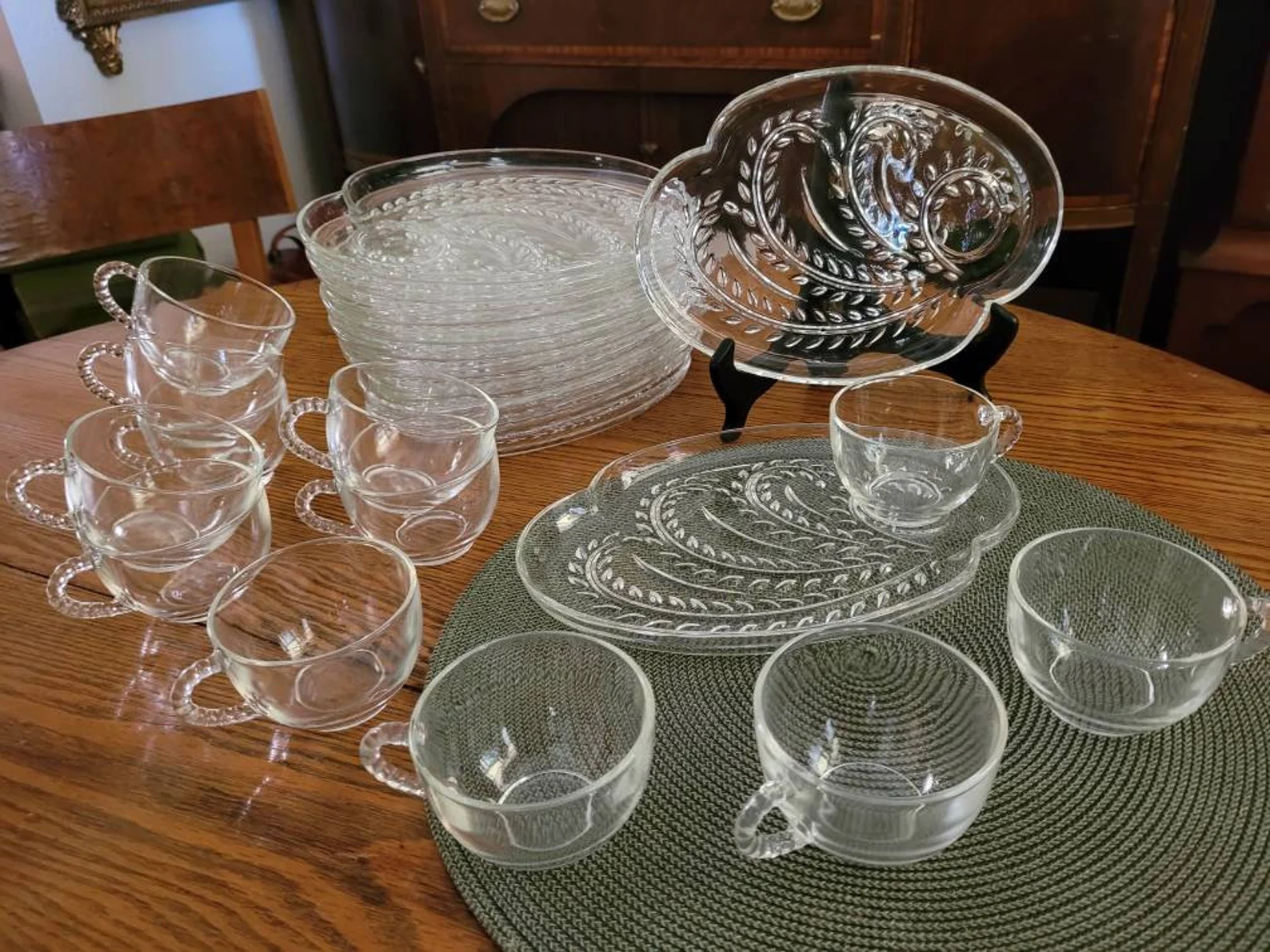
I have an orange juice set. The pitcher is small clear pitcher with oranges painted on. It has four small matching glasses. It looks like it is hand blown.
I have a set of bowls that have the F in a shield. They are white and each one has different colored circles with small curvy lines. Do you have any idea the value of this set.